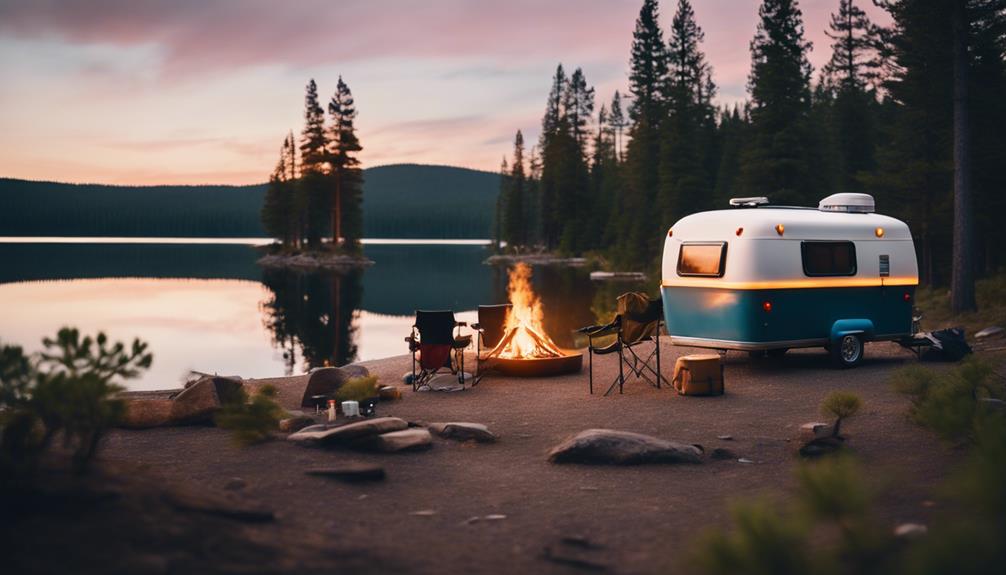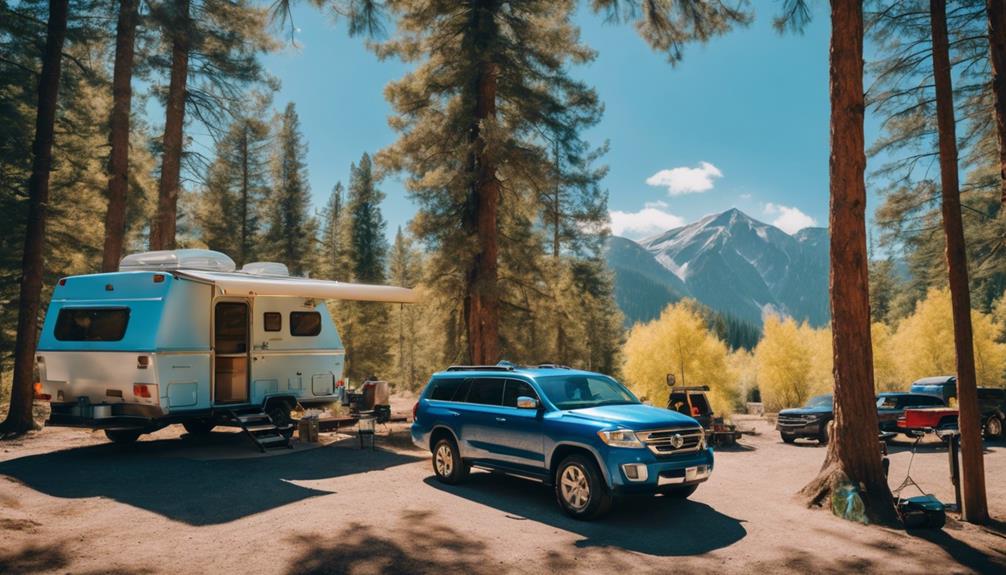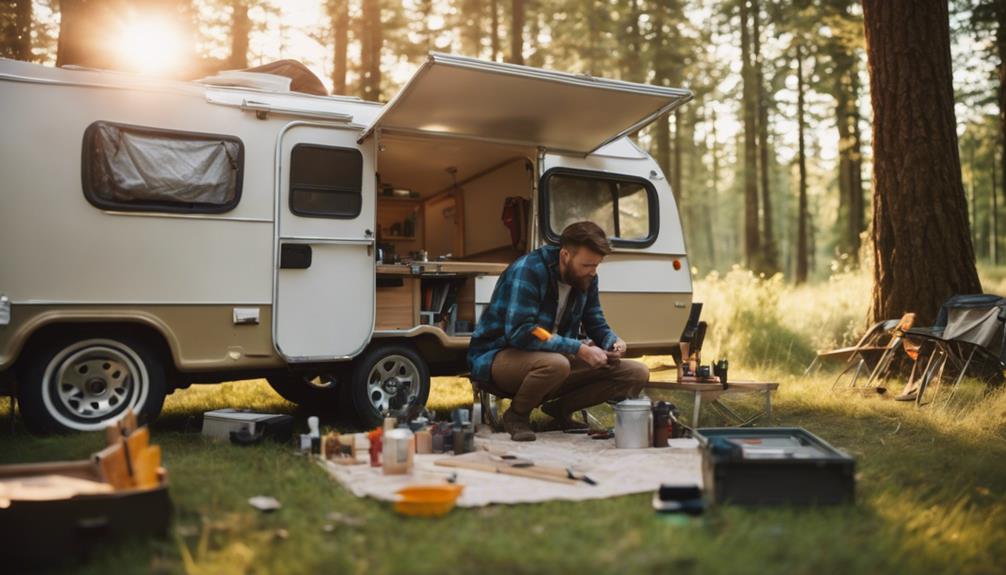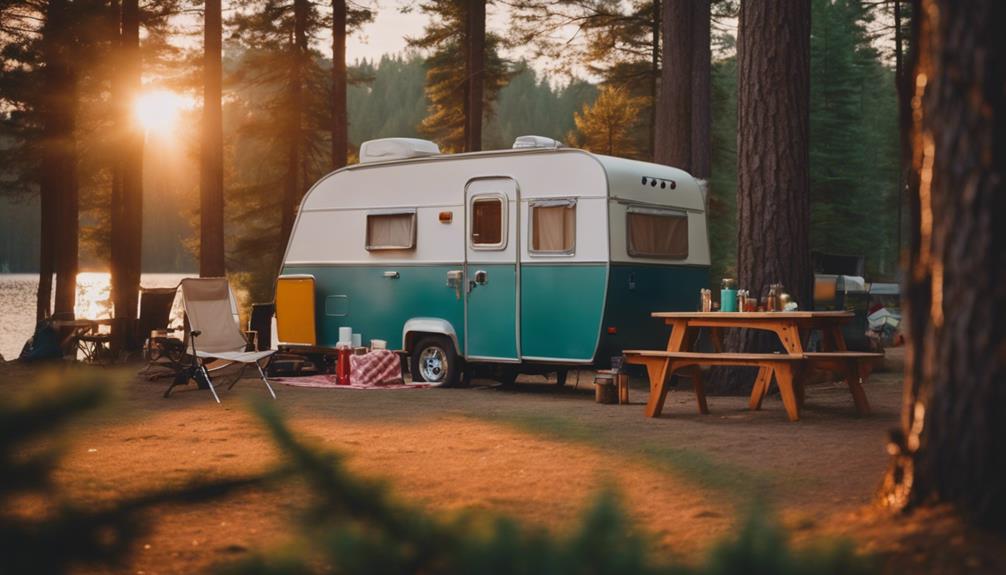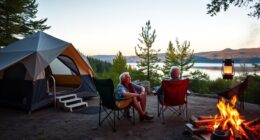To run your pop-up camper off battery power, start by ensuring you've got a fully charged 12-volt battery. Turn off non-essential appliances to conserve energy and regularly monitor your battery levels. If you're planning to camp off-grid, consider solar panels as trickle chargers to extend your battery life. Also, inspect connections and maintenance regularly to prevent power failures. If your battery runs low, recharge it while driving using your vehicle. By managing your energy wisely, you can enjoy your trip without interruptions. Stick around, and you'll uncover even more tips for optimizing your camper's power usage.
Key Takeaways
- Ensure your camper's 12-volt battery is fully charged before heading out to maximize usage during your trip.
- Turn off non-essential electrical components to conserve battery power while camping off-grid.
- Regularly monitor your battery levels to prevent running too low and risking damage.
- Utilize solar panels as trickle chargers to extend battery life during off-grid camping.
Understanding Power Sources
Understanding the power sources for your pop-up camper is vital for guaranteeing a smooth off-grid experience.
Pop-up campers primarily rely on two power sources: DC power from batteries and shore power from campground supplies. When you're dry camping or boondocking, your camper's DC power system becomes essential. It powers important systems like lights, water pumps, and furnaces, while standard outlets won't work without shore power.
A typical camper battery operates on a 12-volt system, and its capacity directly affects how long you can enjoy the comforts of your pop-up camper off-grid. The larger the capacity, the longer you can run your important devices without needing a recharge.
While solar panels can extend your off-grid camping durations by trickle charging your battery, they currently can't support high-power appliances like air conditioners on their own.
Understanding how to manage these power sources will help you make the most of your camping experience. By knowing how to optimize your camper's battery usage and monitor its charge, you can guarantee you're prepared for any adventure while enjoying the great outdoors.
Utilizing Shore Power
When you're plugged into shore power, your pop-up camper's converter box supplies AC power and charges the 12-volt battery, guaranteeing all essential systems stay operational. To maximize your experience, it's important to understand the connection requirements and limitations of shore power.
| Power Requirement | Usage | Notes |
|---|---|---|
| 30 Amp Cord | Standard connection | Supports most appliances |
| 15 Amp Adapter | Limited use only | Avoid for high-demand appliances |
| Rooftop Air Conditioner | Requires 20-30 Amp service | verify power source can handle load |
When using shore power, the outlets inside your camper only function while connected. Regularly check the converter box for tripped breakers, as this can interrupt your power supply. By being aware of these factors, you can fully utilize shore power and enjoy a more comfortable camping experience. Make sure to plan ahead, confirming your power source meets your camper's needs to avoid any unexpected interruptions during your adventures.
Managing DC Power

Managing DC power in your pop-up camper is vital for keeping your essential systems running smoothly while off-grid. When you're dry camping or boondocking, your camper's DC power primarily supports lights, the water pump, the furnace, and the water heater. However, keep in mind that standard outlets won't operate without shore power.
To maximize your off-grid experience, monitor your 12-volt battery levels regularly. The capacity of this battery determines how long you'll stay powered up. If you want to recharge your battery while on the road, make sure your tow vehicle is properly wired for charging; this can greatly extend your off-grid duration.
Regular maintenance of your pop-up camper's DC power system is important. Check the kill switch and battery breaker to prevent any unexpected failures during your adventures.
While solar panels can act as trickle chargers for your battery, remember they won't power high-demand appliances like air conditioners.
Solar Power Options
Solar power options can greatly enhance your pop-up camper experience by extending your off-grid capabilities and ensuring your essential systems stay powered. By using solar panels, you can trickle charge your camper's 12-volt battery, allowing for longer stays without needing to plug in. A 40-watt solar panel typically delivers about 2 amps per hour, while an 80-watt panel can provide around 4 amps per hour, making larger panels a more efficient choice for your needs.
To make the most of your solar power options, consider pairing your panels with energy-efficient appliances. Since current technology can't support high-demand devices like air conditioners solely on solar power, it's wise to optimize your energy use.
Regularly check the output of your solar panels and keep them clean and unobstructed to maximize their efficiency.
Optimizing Battery Life

To get the most out of your pop-up camper's battery, turn off all non-essential electrical components when they're not in use. Even small lights can drain the battery quickly, so make sure you switch them off.
Regularly check and maintain your battery's condition; a fully charged 12-volt battery can only power essential systems like lights and the water pump for a limited time, depending on its capacity.
Consider utilizing solar panels as trickle chargers to extend your battery life while camping off-grid. Even a small 40-watt panel can provide up to 2 amps per hour, although it won't power high-demand appliances like air conditioners.
Additionally, investing in a battery monitor is a smart move. It helps you track usage and remaining capacity, enabling you to manage power consumption effectively and avoid running the battery too low.
Troubleshooting Electrical Problems
Even with careful battery management, you might encounter electrical problems in your pop-up camper that require troubleshooting. Start by checking the kill switch located under the galley lift system; this is a common failure point that can prevent power to your camper's electrical systems. If you're not receiving power, inspect the battery breaker for any tripped breakers, as this can interrupt the flow from the battery.
Next, verify that the converter box's household-type breakers are functioning properly, as a tripped breaker here can affect your camper's overall power supply. Regularly maintaining and inspecting your electrical connections is vital to prevent issues related to corrosion or loose wires that could lead to power loss.
If you're using solar panels, keep in mind that they primarily serve as trickle chargers for the battery and can't power high-demand appliances like air conditioning.
Here's a quick troubleshooting guide:
| Issue | Solution |
|---|---|
| No power to camper | Check kill switch and battery breaker |
| Air conditioning not working | Verify power supply and breaker status |
| Flickering lights | Inspect for loose connections or corrosion |
Maintenance Tips for Longevity

Maintaining your pop-up camper's battery is essential for guaranteeing its longevity and ideal performance during your adventures. Next time you prepare for a trip, check your battery's water levels if it's a flooded lead-acid type. Low water can greatly decrease performance and lifespan.
Make it a habit to inspect and clean the battery terminals regularly. Corrosion can impede electrical flow, affecting overall power efficiency. Also, perform routine checks on the kill switch and battery breaker to guarantee they function properly; any interruptions can disrupt your camping experience.
Pay attention to the camper's converter box and wiring as well. Damaged components can lead to electrical failures and hinder charging capabilities.
To extend your battery's lifespan, consider using a solar panel as a trickle charger when you're off-grid. This guarantees your battery stays charged during longer trips, keeping your power supply reliable.
Frequently Asked Questions
How Many Watts Do You Need to Run a Pop-Up Camper?
To run a pop-up camper, you'll need between 200 to 600 watts for essential systems like lights and pumps. Larger capacity batteries can provide longer usage times, so plan accordingly for your trip.
Can You Run a Camper off a Battery?
Yes, you can run a camper off a battery. It powers essential systems like lights and water pumps. Just monitor your battery levels and make certain it's properly maintained for effective use during your adventures.
How to Hook up Battery to Pop-Up Camper?
You'd think connecting a battery's simple, right? First, find the battery terminal, attach the positive wire, then the negative. Make certain it's secure and check for any loose connections. Voila, your camper's ready for adventure!
How Many Amps Does a Pop-Up Camper Need?
A pop-up camper typically needs 20-30 amps when plugged into shore power for appliances. Off-grid, essential systems like lights and water pumps draw less than 10 amps, allowing you to conserve battery life effectively.
What are the best power tips for running a pop-up camper off a battery?
When installing battery on camper for running a pop-up camper, consider using a deep cycle battery for longer power life. Use LED lights to save energy and invest in a solar panel for recharging. Minimize power usage by unplugging electronics when not in use and avoid running the refrigerator on battery power.
Conclusion
By mastering these power tips, you're not just keeping your pop-up camper running; you're igniting the spark of adventure.
Think of your battery as the heart of your journey, pumping energy to fuel your experiences under the stars.
With careful management and a touch of solar magic, you'll guarantee your adventures don't flicker out.
So, embrace the freedom that comes with knowledge, and let your camper soar like a kite in the wind!


